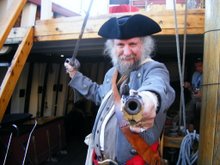Pirate Freedom by Gene Wolfe
There aren't many pirate novels being published these days but this is a good one. Wolfe did a lot of research on pirates, sailing, and geography for this novel.
The plot is fairly straightforward but the set-up is strange. Chris, a boy raised a post-Castro monastery in Cuba goes into the outside world and finds himself in the late 17th century. He becomes a sailor, a captain, a cow killer, and finally a pirate.
The novel is in the form of a confession or memoir written by Chris in the early 20th century where he is a priest looking back at his youth. There is no explanation for the time-travel. It just happens.
If the book has a flaw it is that there are too many coincidences. Nearly everyone that Chris meets returns later. Also, for some reason, all women seem to want him. He has four or five women chasing after him at different points.
The novel is at its best when talking about sailing and actual pirate raids. Without giving a great deal of detail, Wolfe manages to invoke the feeling that he was actually there.
Unlike larger than life characters like Captain Blood, Chris is very human. He makes mistakes and admits them, often judging himself harder than an outsider would.
Sunday, March 30, 2008
Tuesday, March 11, 2008
Long guns
Many pirate books insist that pirates scorned all firearms except pistols and blunderbusses. This is based on a Hollywood-inspired view of how sea battles work.
In the movies two ships will blast away at each other with cannons. Finally they pull alongside and grapple with the pirates swinging across to their prey which they take and lillage moments before it sinks. There are some problems with this.
First, pirates didn't want to sink other ships if they could help it. It could take days to find and transfer all available valuables from one ship to the other. Yes, if they needed to they would blast away with cannons, but this was a last resort.
It was far better to use small arms against an opposing ship. This phase of the battle would go on before the ships were within grappling distance and could go on for some time.
A pistol is a short-range weapon. A blunderbuss is a short-barreled shotgun. It is best when fired into a crowd at short distances. Neither is useful as a ship-to-ship weapon.
That's where the long guns come in. I am lumping muskets, rifles, and carbines together in this classification. Pirates tended to use whatever they could get a hold of.
Sometimes pirates didn't even attack from a ship. There are accounts of pirates taking a ship from dug-out canoes using long guns.
All of this is justification for my newest toy, a snaphaunse musket.
The "modern" flintlock was invented in France around 1630. There were other variations that were in use before this and continued in use decades later. All of them have a pan which holds priming powder. The powder is kept in the pan with a cover. A spring-loaded cock knocks a flint against a striking plate which ignites the priming powder. The resulting flame goes through the touch hole and ignites the main charge.
The flintlock combines the striking plate (called a frizzon here) and the pan cover.
With the snaphaunce the pan cover is separate from the striking plate (called a battery in these locks). In early snaphaunces the musketeer had to open the pan cover by hand but later an internal level was added to the lock to open the pan.
If this seems complicated, it was. I've counted pieces and the snaphaince has at least twice as many pieces as a flintlock. That made it more expensive which is what eventually did it in. Regardless of this, it was a reliable lock and was used from the late 16th century through to the early 18th century. According to The Rifle Shoppe which is where my lock came from, both the lock and the fan-tailed stock usually associated with earlier pieces were still being exported to the colonies at the end of the 17th century.
This means that pirates must have had some. Like I said, they tended to use whatever they could get a hold of.
Flintlocks are probably over represented at pirate events. This is understandable. They are still cheaper to make and much more common. Many pirate reenactors use later century weapons from a time when most guns were flintlocks.
In the movies two ships will blast away at each other with cannons. Finally they pull alongside and grapple with the pirates swinging across to their prey which they take and lillage moments before it sinks. There are some problems with this.
First, pirates didn't want to sink other ships if they could help it. It could take days to find and transfer all available valuables from one ship to the other. Yes, if they needed to they would blast away with cannons, but this was a last resort.
It was far better to use small arms against an opposing ship. This phase of the battle would go on before the ships were within grappling distance and could go on for some time.
A pistol is a short-range weapon. A blunderbuss is a short-barreled shotgun. It is best when fired into a crowd at short distances. Neither is useful as a ship-to-ship weapon.
That's where the long guns come in. I am lumping muskets, rifles, and carbines together in this classification. Pirates tended to use whatever they could get a hold of.
Sometimes pirates didn't even attack from a ship. There are accounts of pirates taking a ship from dug-out canoes using long guns.
All of this is justification for my newest toy, a snaphaunse musket.
The "modern" flintlock was invented in France around 1630. There were other variations that were in use before this and continued in use decades later. All of them have a pan which holds priming powder. The powder is kept in the pan with a cover. A spring-loaded cock knocks a flint against a striking plate which ignites the priming powder. The resulting flame goes through the touch hole and ignites the main charge.
The flintlock combines the striking plate (called a frizzon here) and the pan cover.
With the snaphaunce the pan cover is separate from the striking plate (called a battery in these locks). In early snaphaunces the musketeer had to open the pan cover by hand but later an internal level was added to the lock to open the pan.
If this seems complicated, it was. I've counted pieces and the snaphaince has at least twice as many pieces as a flintlock. That made it more expensive which is what eventually did it in. Regardless of this, it was a reliable lock and was used from the late 16th century through to the early 18th century. According to The Rifle Shoppe which is where my lock came from, both the lock and the fan-tailed stock usually associated with earlier pieces were still being exported to the colonies at the end of the 17th century.
This means that pirates must have had some. Like I said, they tended to use whatever they could get a hold of.
Flintlocks are probably over represented at pirate events. This is understandable. They are still cheaper to make and much more common. Many pirate reenactors use later century weapons from a time when most guns were flintlocks.
Subscribe to:
Posts (Atom)

